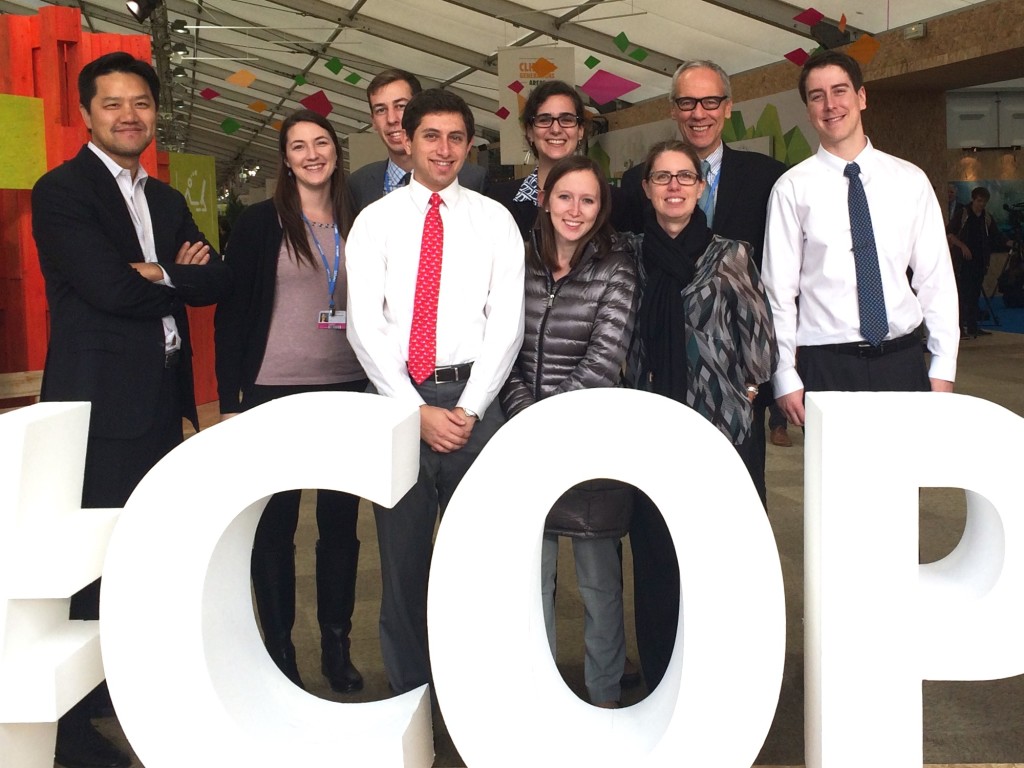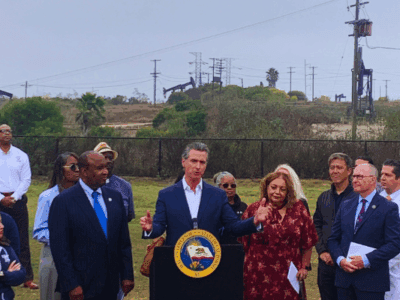Paris COP update, Paris COP in context
 The climate meetings in in Paris have descended into the usual maelstrom of intensive negotiations in long long days in many parallel meetings. I noted in my post the other day that there is a feeling of higher-than-usual stakes for this meeting. This was highlighted by the visit to negotiators last night by French Foreign Minister Laurent Fabius, who reminded negotiators that he wants them to produce “clean text” by Saturday, to deliver to Ministers when they take over negotiations next week. “Clean text” means text that has resolved most outstanding issues, including all that are merely alternative language with small or no stakes, leaving a small number of clearly articulated alternative choices on the highest-stakes and most challenging issues to structure the agenda for political negotiations among Ministers. Although negotiators are making progress, this is still a tall order in view of the hundreds of bracketed words and passages and the 50-odd page length of the current text. I suppose the most promising sign so far is the intensity with which work has proceeded in the first few days of a two-week meeting, with work proceeding late into the night and a feeling of intense crunch that normally only grows near the end of negotiations. The least promising sign is the number of occasions where little or no progress is being made on passages that don’t appear to be worth it, as many delegations are insisting on language that reflects their few large-scale priorities be replicated in dozens of places throughout the text.
The climate meetings in in Paris have descended into the usual maelstrom of intensive negotiations in long long days in many parallel meetings. I noted in my post the other day that there is a feeling of higher-than-usual stakes for this meeting. This was highlighted by the visit to negotiators last night by French Foreign Minister Laurent Fabius, who reminded negotiators that he wants them to produce “clean text” by Saturday, to deliver to Ministers when they take over negotiations next week. “Clean text” means text that has resolved most outstanding issues, including all that are merely alternative language with small or no stakes, leaving a small number of clearly articulated alternative choices on the highest-stakes and most challenging issues to structure the agenda for political negotiations among Ministers. Although negotiators are making progress, this is still a tall order in view of the hundreds of bracketed words and passages and the 50-odd page length of the current text. I suppose the most promising sign so far is the intensity with which work has proceeded in the first few days of a two-week meeting, with work proceeding late into the night and a feeling of intense crunch that normally only grows near the end of negotiations. The least promising sign is the number of occasions where little or no progress is being made on passages that don’t appear to be worth it, as many delegations are insisting on language that reflects their few large-scale priorities be replicated in dozens of places throughout the text.
Substance of the Negotiations:
Although there are several distinct legal bodies with different mandates meeting in parallel – and there will be different ones meeting next week – the most important and contentious action is in the “Ad hoc Group on the Durban Platform for Enhanced Action” (ADP), the body established at the 2011 Durban meeting to negotiate a new climate agreement under the Framework Convention. Negotiations are structured with a formal plenary body (used for very little), a “contact group” (sort of a committee of the whole, the highest-level body where something like actual negotiating takes place, principally used to assess views and review and comment on progress on multiple areas of negotiation), roughly ten (I lost count) “Spin-off groups” each conducting more focused and in-depth review of specific “thematic areas” (large blocks of text, typically from one to a few articles of the draft agreement or equivalent), and “informal informals” (narrowly targeted groups, with specific parties requested to participate in small rooms, to work intensively on small, difficult issues under the purview of a particular spin-off group.
In all these groups working on the Durban Platform, the major issues to be resolved remain those I identified in my opening post on the meeting a couple of days ago – most importantly, 1) the statement or re-statement of a long-term goal to limit global heating (and how to treat the existing 2 C goal versus the proposal being advanced of 1.5 C); 2) language on mitigation, meaning the interpretation and legal status of the INDCs (the separate statements of intended national contributions that have been brought forward by 157 nations); 3) Language on adaptation; 4) The inclusion and treatment of “loss and damage”; 5) Finance and other forms of support for developing countries (some or all?) in meeting their commitments, and; 6) Transparency, meaning provisions for reporting, monitoring, review, and/or assessment of countries’ performance relative to their commitments.
In tense sessions of the Contact Group this afternoon and evening, the discussions were re-organized around a set of so-called “cross-cutting issues” – important and contentious issues that appear in slightly different forms in multiple places throughout the text. The co-chairs identified six such issues:
- Ambition: Having started the process with the completely decentralized process of national submission of INDCs – and in view of obvious and universally recognized fact that the emissions commitments in these INDCs fall far short of being strong enough to put the world on track toward the stated 2 C goal, how can this agreement be crafted to maximize individual and collective ambition to achieve more?
- Progression: Closely related to ambition, how should decisions here embed requirements, processes, or exhortations to strengthen efforts, and thus advance achievement of aims of Convention, over time – notwithstanding the fact that these aims of the convention are themselves subject to widely different interpretations, or at least different relative priorities, for different parties.
- Legal form: What legal form shall the Paris agreements and decisions take, and how legally binding can various parts be? As per my previous post, on this issue the boundary is mainly driven by a combination of constitutional and political constraints in the United States – and by other parties’ guesses of just how tightly binding these constraints are on what the US delegation can accept.
- Differentiation: How are all the provisions being negotiated – i.e., those related to mitigation adaptation, finance, and reporting and other procedural obligations – differentiated among parties, in accordance with the Framework Convention’s “Principle of common but differentiated responsibility” (CBDR)?
- Special circumstances: In a sense, a subset of differentiation – but more precisely, concerned with explicit identification of countries facing special circumstances beyond being developing countries – i.e., the least developed, or those especially vulnerable to climate change – for special provisions, either in the form of additional support or relaxation of obligations that would otherwise apply.
After a slow start, including a remarkable two-minute period in which no delegation asked to speak after the chair opened the floor, this afternoon’s discussion of these cross-cutting issues devolved into a discouraging recitation of long-standing rote positions, principally divided along North/South lines. By the time the Contact Group resumed meeting this evening, there was abundant evidence of frustration and frayed tempers, with several parties stating that they had been working in good faith and showing constructive flexibility, and their efforts were met with stonewalling and bad faith. After a long pause for a consultation among the G-77 and China, the group returned with a request for the Co-chairs (of the Target Group) and co-facilitators (of the thematic Spin-off Groups) to develop clean text that bridges differences and leaves clear options to put in front of Parties to begin tomorrow’s work. The ADP groups’ mandates continue all day tomorrow (Friday), then until noon on Saturday, at which point ADP work must cease and the ADP must deliver its text to the Conference of the Parties – which itself will shift to negotiations among Ministers through the end of the conference next week. The co-chairs previously tried to produce just such clean text with points of important difference highlighted prior to the last negotiation meeting in October, but developing-country parties rejected that text as unbalanced and as unfavorably pre-judging many issues of importance to them, so the October meeting was spent pouring long, repetitive passages of bracketed, often highly duplicative text, back into the document – thereby increasing its length from 8 pages to 52. Efforts this week are largely dedicated to trying to reverse that operation, this time with broader buy-in and a looming deadline. We will see if this time the co-chairs succeed better at identifying text in the range of what is broadly acceptable, or if the parties are more trusting or tolerant of their work if it falls a little short.
Some reflections on process.
In addition to their growing frustration with each other, many delegates expressed frustration with the process by which they were working. With so many points unresolved across a long text, and so many linkages among them – both in the sense of the same issue appearing repeatedly, and in the sense that there are a small number of big issues that are the core points of different preferences, that are worth bargaining over – it is problematic to divide conversations up into narrowly focused spin-off groups and even more narrowly focused “informal informals” — because except in those lucky cases where all that is required is to clean up clumsy, vague, or duplicative drafting, the range of issues addressed within such groups are often too narrow to allow mutually advantageous deals. So it is difficult for any party to concede in a spin-off group on any issue of importance to them, because there is often nothing of similar value they can get in return within that group, and the structure hinders identifying and making exchanges across groups.
In the Contact Group, negotiation faces the opposite problem. The agenda is too vast. Parties themselves often cannot see the shape of packages deals – this resolution of issue A, this resolution of issue B, this resolution of issue C – that may be attractive, or at least acceptable, to most or all parties. And absent extremely skillful management of the process, parties are usually unwilling to take the risk of making exploratory proposals that package some benefits and some concessions, because unless others reciprocate that kind of open non-binding exploration (and communicate their preferences honestly), such tactics can be disadvantageous.
This much is theory. But in the afternoon contact group, it played out in practice. Parties were palpably frustrated that in view of the number of issues they were facing, they were unable to identify potentially advantageous package deals, so they just kept reiterating conceptual arguments and familiar positions. Several parties even asked the co-chairs to take a more active role in structuring the discussions, e.g., by selecting several text passages the highlighted one cross-cutting issue and putting them up to examine and consider modifications all together. The co-chairs refused to do this, stating that they work for the parties and it was up to the parties to figure out how to discuss the cross-cutting issues. Cara and I discussed this on the bus home tonight, and found we had several theories why the co-chairs made this choice. Perhaps the task of identifying all the passages that deal with, say, ambition or differentiation, was much longer, harder, and more contentious than it appeared, so did not have the time to do it. Perhaps they sensed that parties needed to vent, by singing their old familiar songs. Perhaps, following the advice of Law-of-the-Sea Chair Tommy Koh, they have a good sense of where broadly acceptable compromise text would lie, but know they cannot bring it out until parties have reached a critical point of frustration, because only then are they liable to accept it. And perhaps, having so forcefully rebuffed by parties after their October attempt to present clean text, they wanted to demonstrate to the parties how little progress is possible on a complex agenda if a passive chair leaves parties entirely in the driver’s seat. We will get some data to test these hypotheses when we see 1) what kind of text the co-chairs bring back tomorrow morning, and 2) how willing the Parties are to accept that text.
The Paris COP in context:
In the inevitable energy and enthusiasm that builds around reaching an agreement in Paris next week, it is important to keep some perspective about what nations are doing here.
Since the more-or-less failures of international action on climate change under the first commitment period of the Kyoto Protocol, and at Copenhagen in 2009, there has been a clear decision to shift the entire structure of mitigation negotiations to a bottom-up process, whereby nations develop their own INDCs saying what actions they will take and what they plan thereby to achieve. The decentralized production of voluntary national commitments, followed by some still-to-be-determined process of review, assessment, and strengthening over time, is the core of this approach. But this bottom-up approach explicitly eliminates the element of reciprocal, mutually conditional commitments that are the essence of solving collective-action problems. Absent such linkage, theory says that every state’s incentive is to promise little and deliver less.
Theory may be wrong, of course. I have argued that the collective-action aspects of managing climate change have been substantially over-stated – a claim that has the radical implication that reciprocal commitments need not be so tightly linked, and measures for monitoring and verification are less important – at least for the near-term first steps to start cutting emissions. But so long as there are any significant collective-action aspects to the process, it is still preferable to have linked, mutually conditional commitments than separate independent ones, if you can get them. So this negotiation process has given up one of the strongest tools to advance ambition, linkage of performance commitments.
The actual INDCs submitted support this suggestion. As I reported the other day, independent analyses of the effects of all submitted INDCs suggest that – if fully implemented – they will reduce projected global-average heating by the end of this century from a really scary 4.5 degrees C, to a somewhat less scary but still seriously disruptive 3.5 degrees C. (4.5 C is 8 F, 3.5 C is 6.3 F – and remember, this is global-average: land heats more than ocean, and mid to high latitudes heat more than tropics, so average changes over the US would be of order 50% higher than changes in the global average). So as I posted earlier in the week – even the strongest agreement being considered here counts as getting off the starting line, and much better than nothing – but falls far far short of what is needed to limit the slow-motion train-wreck that is global climate change.
Reader Comments
One Reply to “Paris COP update, Paris COP in context”
Comments are closed.







Dear Ted,
Thanks for your painfully honest and articulate update. The only “winners” are those delegates who skip the meetings and have fun in Paris. The daily tragedy of islamic terrorism informs the world of the utter stupidity of climate hysteria.